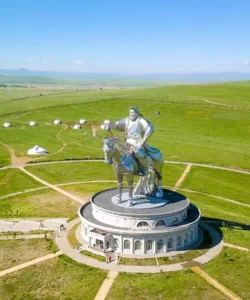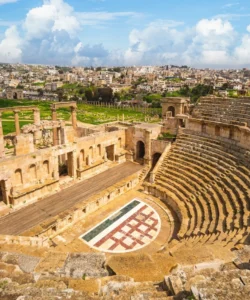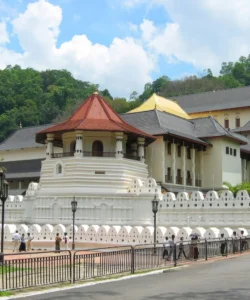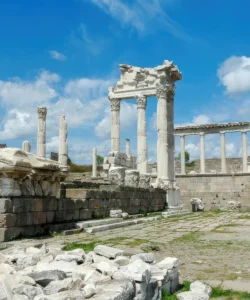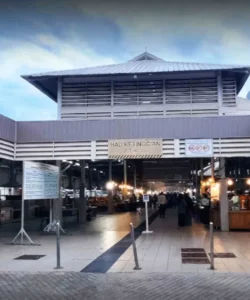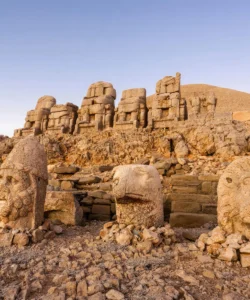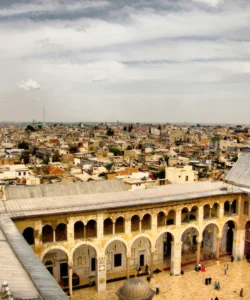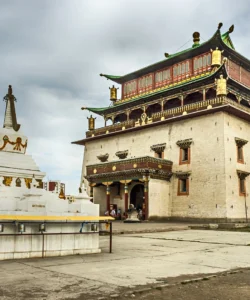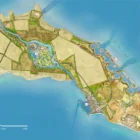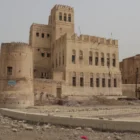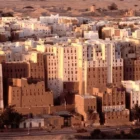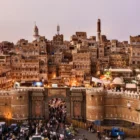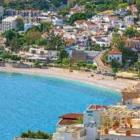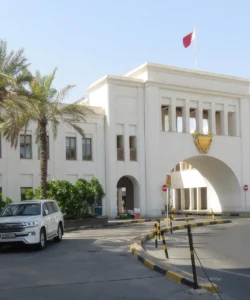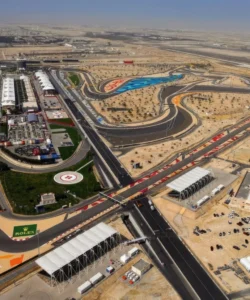The Bahrain National Museum is the largest and oldest public museum in Bahrain, offering a comprehensive journey through 6,000 years of the nation’s rich history, culture, and traditions. Opened in 1988, it’s considered one of the finest museums in the Gulf region.
Listen to an introduction about Bahrain National Museum
Name and Address
- Name: Bahrain National Museum (Arabic: متحف البحرين الوطني)
- Address: Shaikh Hamad Causeway, Manama, 323, Bahrain.
- Location: Situated on an artificial peninsula in Manama, adjacent to the National Theatre of Bahrain, offering views of the Arabian Gulf and Muharraq Island.
How to Get There
The Bahrain National Museum is centrally located in Manama and easily accessible.
- By Car/Taxi/Rideshare: This is the most convenient way to reach the museum, typically a short drive from most parts of Manama. Ample parking space is available.
- Public Transportation: Bus routes (e.g., 19, A1) pass near the museum, providing an economical option.
- Visitor Access:
- The museum is generally open to the public daily from 8:00 AM to 8:00 PM, though some sources indicate earlier closing times (e.g., 3:00 PM or 6:00 PM on certain days). It’s always best to check their official website or call ahead for the most current hours, especially during public holidays.
- Admission: There is an entry fee for visitors (e.g., BHD 1.1 or BHD 2 for foreigners), though children under 6 often enter for free.
- Tours: While not always guided, the museum provides clear signage in both English and Arabic, making it easy to explore independently. Audio guides may also be available.
Landscape and Architecture
Designed by Danish architects Krohn & Hartvig Rasmussen, the Bahrain National Museum is a magnificent postmodern building that harmoniously blends with its coastal environment.
- Striking Location: The museum is built on an artificial peninsula, creating a unique setting where the building’s white travertine marble facade reflects in the surrounding water, symbolizing Bahrain’s connection to the sea.
- Modern Design with Islamic Influence: The architecture, while Nordic in its origins, respectfully incorporates elements inspired by traditional Islamic architecture, featuring clean lines, simple geometry, and a subtle, restrained exterior.
- Interior Layout: The expansive 27,800-square-meter complex comprises two connected buildings. The main building houses nine major galleries, temporary exhibition halls, an art gallery, a lecture hall, a gift shop, and a café. The administrative offices, conservation laboratories, and storage areas are located in the administrative building.
- Exhibition Halls: The museum features six main halls, each dedicated to a different aspect of Bahrain’s heritage:
- Hall of Burial Mounds: Showcases the ancient Dilmun burial practices, including an actual reconstructed burial mound.
- Hall of Dilmun: Focuses on the artifacts and history of the Dilmun civilization (5000 BC to 400 BC), including its trade networks.
- Hall of Tylos and Islam: Covers Bahrain’s Hellenic-influenced history and its adoption of Islam until the 18th century, with artifacts from the Khamis Mosque.
- Hall of Documents and Manuscripts: Displays rare copies of the Qur’an, astronomical notes, and historical documents.
- Hall of Customs and Traditions: Depicts pre-oil era life in Bahrain with intricate models, dioramas, and traditional household items.
- Hall of Traditional Crafts: Showcases various traditional Bahraini handicrafts like pottery, weaving, and boat-building.
- Natural History Hall (added in 1993): Features specimens of Bahrain’s flora and fauna.
- Interactive Elements: The museum utilizes interactive exhibits, multimedia displays, and large-scale maps (like a massive satellite map of Bahrain on the ground floor) to enhance the visitor experience.
What Makes It Famous
The Bahrain National Museum’s fame rests on its comprehensive historical narrative, architectural brilliance, and cultural significance:
- Guardian of 6,000 Years of History: It is renowned for its extensive collection of archaeological artifacts and exhibits that chronicle Bahrain’s long and diverse history, from the Dilmun civilization to its more recent past.
- Leading Cultural Center: Beyond its role as a museum, it functions as a vibrant cultural hub, hosting numerous events, exhibitions, and educational activities throughout the year.
- Architectural Masterpiece: Its striking postmodern design, reflective travertine facade, and intelligent use of light make it an architectural landmark that seamlessly blends with its coastal surroundings.
- Immersive Cultural Experience: The detailed reconstructions of traditional life and crafts provide an immersive experience, allowing visitors to vividly imagine Bahrain’s pre-oil era.
- Region’s First Modern Museum: As one of the first modern museums in the Gulf region, it set a precedent for cultural institutions in the area.
Differences from Some Other Landmarks
The Bahrain National Museum distinguishes itself from other regional landmarks in several ways:
- Comprehensive Historical Overview vs. Specific Focus: While Bahrain Fort offers a deep dive into an archaeological site and its multiple historical layers, and Al Fateh Grand Mosque focuses on religious worship and modern Islamic architecture, the National Museum provides a broad and chronological overview of Bahrain’s entire history, from ancient civilizations to recent traditions.
- Curated Indoor Experience: Unlike open-air historical sites or grand religious structures, the museum offers a climate-controlled, curated indoor environment for learning and reflection, making it a comfortable visit even during hot months.
- Educational and Research Hub: With its extensive collection, detailed exhibits, and role in cultural programs, it serves as a significant educational and research institution, which differs from landmarks primarily known for their visual appeal or singular function.
- Reconstructed History: The museum’s use of intricate models and reconstructed scenes (like the traditional souq) allows visitors to step into the past in a way that outdoor ruins or active government buildings cannot.
Bahrain National Museum Photos:































